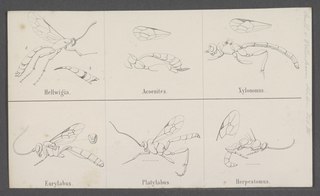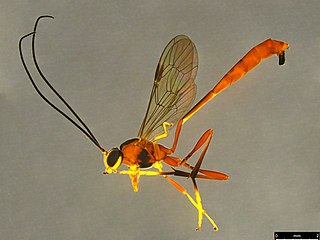
The Ichneumonidae, also known as ichneumon wasps, ichneumonid wasps, ichneumonids, or Darwin wasps, are a family of parasitoid wasps of the insect order Hymenoptera. They are one of the most diverse groups within the Hymenoptera with roughly 25,000 species described as of 2016. However, this likely represents less than a quarter of their true richness as reliable estimates are lacking, along with much of the most basic knowledge about their ecology, distribution, and evolution. It is estimated that there are more species in this family than there are species of birds and mammals combined. Ichneumonid wasps, with very few exceptions, attack the immature stages of holometabolous insects and spiders, eventually killing their hosts. They thus fulfill an important role as regulators of insect populations, both in natural and semi-natural systems, making them promising agents for biological control.
Claude Morley was an English antiquary and entomologist who specialised in Hymenoptera and Diptera. He has been described by Peter Marren as "Suffolk's best-known entomologist".

Banchinae is a subfamily of ichneumonid parasitoid wasps containing about 1,500 species; the genera Glypta and Lissonota are very large. The three tribes are all distributed worldwide.

Acaenitinae is a subfamily of the parasitoid wasp family Ichneumonidae. Female Acaenitinae have a large triangular projecting genital plate.

Hellwigia is a genus of ichneumon wasps. A specimin of the species was reared by scientists for the first time in the Netherlands.

Lusius is a genus of parasitoid wasps in the tribe Phaeogenini Förster, 1869 or Alomyini Förster, 1869, first described by Pierre Jules Tosquinet in 1903, published after his death. The genus is similar in appearance to species in the genus Heterischnus. Lusius occurs in the Oriental, Afrotropical, Neotropical and Australasian biogeographical regions.

Netelia is a genus of ichneumonid wasps in the subfamily Tryphoninae. There are over 330 described species in Netelia grouped into 12 subgenera.

Rhyssinae is a subfamily of parasitoid wasps in the family Ichneumonidae. It contains eight genera and 259 described species, but there are likely many undiscovered species.
Dolichomitus is a genus of ichneumon wasps in the family Ichneumonidae. There are at least 70 described species in Dolichomitus. The name is derived from the Greek dolicho, meaning long or narrow, and the Greek mitus, meaning a thread.

Acrodactyla is a genus of insect belonging to the family Ichneumonidae.

Agriotypus is a genus of insect belonging to the family Ichneumonidae first described by John Curtis in 1832.
Campoletis is a genus of parasitoid wasps belonging to the family Ichneumonidae.

Diphyus is a genus of parasitoid wasps belonging to the family Ichneumonidae.

Habronyx is a genus of parasitoid wasps belonging to the family Ichneumonidae. The species of this genus are found in Europe, Australia, and North and South America.

Venturia is a genus of parasitoid wasps belonging to the family Ichneumonidae.
Syzeuctus is a genus of parasitoid wasps belonging to the family Ichneumonidae.

Xanthopimpla is a genus of parasitoid wasps belonging to the family Ichneumonidae.

Netelia producta is a species of ichneumonid wasp in the subfamily Tryphoninae found in Australia.
Habronyx fulvipes is a species of parasitic ichneumon wasp. It was renamed by Townes, Momoi and Townes in 1965 ; prior to that the species had been named Habronyx chinensis, chinensis meaning "China", in 1955 by Japanese entomologist Toichi Uchida. The holotype and allotype were collected by R. Mell. The species was first named Exochilum Chinense by Morley in 1913.












